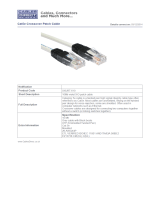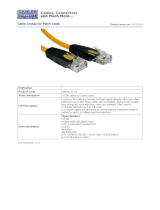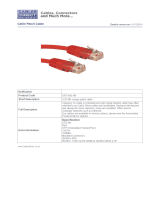Page is loading ...

As our products undergo continuous development the specifications are subject to change without prior notice
DG-FS4528/DG-FS4552
Layer 2 Fast Ethernet Managed Switch
Installation Guide
V1.0.2
2013-05-15
MUSTANG 4000 Managed Switch Series

COPYRIGHT
Copyright © 2013 by Smartlink Network Systems Limited. All rights reserved. No
part of this publication may be reproduced, transmitted, transcribed, stored in a
retrieval system, or translated into any language or computer language, in any
form or by any means, electronic, mechanical, magnetic, optical, chemical, man-
ual or otherwise, without the prior written permission of this company.
This company makes no representations or warranties, either expressed or
implied, with respect to the contents hereof and specifically disclaims any warran-
ties, merchantability or fitness for any particular purpose. Any software described
in this manual is sold or licensed “as is”. Should the programs prove defective fol-
lowing their purchase, the buyer (and not this company, its distributor, or its
dealer) assumes the entire cost of all necessary servicing, repair, and any inciden-
tal or consequential damages resulting from any defect in the software. Further,
this company reserves the right to revise this publication and to make changes
from time to time in the contents thereof without obligation to notify any person of
such revision or changes.

Installation Guide
DG-FS4528/DG-FS4552 Fast Ethernet Switch
Layer 2 Workgroup Switch
with 24/48 10/100BASE-T (RJ-45) Ports,
and 4 Combination Gigabit (RJ-45/SFP) Ports

DG-FS4528
DG-FS4552
E102010-AP-R01
150000000234A

i
About This Guide
Purpose
This guide details the hardware features of the switch, including the physical and
performance-related characteristics, and how to install the switch.
Audience
The guide is intended for use by network administrators who are responsible for installing
and setting up network equipment; consequently, it assumes a basic working knowlede of
LANs (Local Area Networks).
Conventions
The following conventions are used throughout this guide to show information:
Note: Emphasizes important information or calls your attention to related features or
instructions.
Caution: Alerts you to a potential hazard that could cause loss of data, or damage the
system or equipment.
Warning: Alerts you to a potential hazard that could cause personal injury.
Related Publications
The following publication gives specific information on how to operate and use the
management functions of the switch:
The User Manual
Also, as part of the switch’s software, there is an online web-based help that describes all
management related features.
Revision History
This section summarizes the changes in each revision of this guide.
January 2011 Revision
This is the second revision of this guide.

ii

iii
Contents
Chapter 1: Introduction 1-1
Overview 1-1
Switch Architecture 1-2
Network Management Options 1-2
Description of Hardware 1-2
10/100BASE-T Ports 1-2
SFP Slots 1-2
Port and System Status LEDs 1-3
Power Supply Sockets 1-4
Features and Benefits 1-4
Connectivity 1-4
Expandability 1-5
Performance 1-5
Management 1-5
Chapter 2: Network Planning 2-1
Introduction to Switching 2-1
Application Examples 2-2
Collapsed Backbone 2-2
Network Aggregation Plan 2-3
Remote Connection with Fiber Cable 2-4
Making VLAN Connections 2-5
Application Notes 2-6
Chapter 3: Installing the Switch 3-1
Selecting a Site 3-1
Ethernet Cabling 3-1
Equipment Checklist 3-2
Package Contents 3-2
Optional Rack-Mounting Equipment 3-2
Mounting 3-3
Rack Mounting 3-3
Desktop or Shelf Mounting 3-4
Installing an Optional SFP Transceiver 3-5
Connecting to a Power Source 3-6
Connecting to the Console Port 3-7
Wiring Map for Serial Cable 3-7

Contents
iv
Chapter 4: Making Network Connections 4-1
Connecting Network Devices 4-1
Twisted-Pair Devices 4-1
Cabling Guidelines 4-1
Connecting to PCs, Servers, Hubs and Switches 4-1
Network Wiring Connections 4-2
Fiber Optic SFP Devices 4-3
Connectivity Rules 4-4
1000BASE-T Cable Requirements 4-4
1000 Mbps Gigabit Ethernet Collision Domain 4-5
100 Mbps Fast Ethernet Collision Domain 4-5
10 Mbps Ethernet Collision Domain 4-5
Cable Labeling and Connection Records 4-6
Appendix A: Troubleshooting A-1
Diagnosing Switch Indicators A-1
Power and Cooling Problems A-1
Installation A-1
In-Band Access A-2
Appendix B: Cables B-1
Twisted-Pair Cable and Pin Assignments B-1
10BASE-T/100BASE-TX Pin Assignments B-1
Straight-Through Wiring B-2
Crossover Wiring B-2
1000BASE-T Pin Assignments B-3
Appendix C: Specifications C-1
Switch Features C-2
Management Features C-2
Standards C-3
Glossary
Index

v
Tables
Table 1-1 DG-FS4552 Port Status LEDs 1-3
Table 1-2 System Status LEDs 1-4
Table 3-1. Serial Cable Wiring 3-7
Table 4-1. Maximum 1000BASE-T Gigabit Ethernet Cable Length 4-5
Table 4-2. Maximum 1000BASE-SX Gigabit Ethernet Cable Length 4-5
Table 4-3. Maximum 1000BASE-LX Gigabit Ethernet Cable Length 4-5
Table 4-4. Maximum 1000BASE-LH Gigabit Ethernet Cable Length 4-5
Table 4-5. Maximum Fast Ethernet Cable Length 4-5
Table 4-6. Maximum Ethernet Cable Length 4-5
Table A-1. Troubleshooting Chart A-1
Table B-1. 10/100BASE-TX MDI and MDI-X Port Pinouts B-2
Table B-2. 1000BASE-T MDI and MDI-X Port Pinouts B-3

vi
Figures
Figure 1-1. DG-FS4552 Front and Rear Panels 1-1
Figure 1-2. DG-FS4552 Port Status LEDs 1-3
Figure 1-3. DG-FS4552 System Status LED 1-3
Figure 1-4. DG-FS4552 Power Supply Sockets 1-4
Figure 2-1. Collapsed Backbone 2-2
Figure 2-2. Network Aggregation Plan 2-3
Figure 2-3. Remote Connection with Fiber Cable 2-4
Figure 2-4. Making VLAN Connections 2-5
Figure 3-1. RJ-45 Connections 3-2
Figure 3-2. Attaching the Brackets 3-3
Figure 3-3. Installing the Switch in a Rack 3-4
Figure 3-4. Attaching the Adhesive Feet 3-4
Figure 3-5. Inserting an SFP Transceiver into a Slot 3-5
Figure 3-6. Power Sockets 3-6
Figure 3-7. Serial Port (DB-9 DTE) Pin-Out 3-7
Figure 4-1. Making Twisted-Pair Connections 4-1
Figure 4-2. Network Wiring Connections 4-2
Figure 4-3. Making Fiber Port Connections 4-4
Figure B-1. RJ-45 Connector Pin Numbers B-1
Figure B-2. Straight-through Wiring B-2
Figure B-3. Crossover Wiring B-3

1-1
Chapter 1: Introduction
Overview
The DG-FS4528/52 is an intelligent switch with 24/48 10/100BASE-T ports, and four
Gigabit combination ports
1
that are comprised of a RJ-45 port and an SFP
transceiver slot. There is also an SNMP-based management agent embedded on
the main board. This agent supports both in-band and out-of-band access for
managing the switch.
This switch provides a broad range of powerful features for Layer 2 switching,
delivering reliability and consistent performance for your network traffic. It brings
order to poorly performing networks by segregating them into separate broadcast
domains with IEEE 802.1Q compliant VLANs, and empower multimedia applications
with multicast switching and CoS services.
Figure 1-1. DG-FS4552 Front and Rear Panels
1. RJ-45 ports shared with a SFP tranceiver slots. If an SFP transceiver is plugged in, the
corresponding RJ-45 port is disabled.
Mustang
4000 Series Switch
DG-FS4552
Mustang
4000 Series Switch
DG-FS4552
10/100 Mbps RJ-45 Ports
Console Port
System Indicators
Combination Gigabit Ports
Power Socket
Port Status Indicators

Introduction
1-2
1
Switch Architecture
The DG-FS4528/52 employs a wire-speed, non-blocking switching fabric. This
permits simultaneous wire-speed transport of multiple packets at low latency on all
ports. The DG-FS4528/52 also features full-duplex capability on all ports, which
effectively doubles the bandwidth of each connection.
The switch uses store-and-forward switching to ensure maximum data integrity. With
store-and-forward switching, the entire packet must be received into a buffer and
checked for validity before being forwarded. This prevents errors from being
propagated throughout the network.
Network Management Options
The switch contains a comprehensive array of LEDs for “at-a-glance” monitoring of
network and port status. They also include a management agent that allows you to
configure or monitor the switch using its embedded management software, or via
SNMP applications. To manage a switch, you can make a direct connection to the
RS-232 console port (out-of-band), or you can manage it through a network
connection (in-band) using Telnet, the on-board Web agent, or Windows-based
network management software.
For a detailed description of the switch’s advanced features, refer to the
DG-FS4528/52 User Manual.
Description of Hardware
10/100BASE-T Ports
The DG-FS4528/52 contains 24/48 RJ-45 ports that operate at 10 Mbps or 100
Mbps, half or full duplex. All ports support automatic MDI/MDI-X operation, you can
use straight-through cables for all network connections to PCs or servers, or to other
switches or hubs. (See "10BASE-T/100BASE-TX Pin Assignments" on page B-1.)
Each of these ports support auto-negotiation, so the optimum transmission mode
(half or full duplex), and data rate (10 or 100 Mbps) can be selected automatically. If
a device connected to one of these ports does not support auto-negotiation, the
communication mode of that port can be configured manually.
Each port also supports auto-negotiation of flow control, so the switch can
automatically prevent port buffers from becoming saturated.
SFP Slots
The Small Form Factor Pluggable (SFP) transceiver slots are shared with four of the
RJ-45 ports. In its default configuration, if an SFP transceiver (purchased
separately) is installed in a slot and has a valid link on its port, the associated RJ-45
port is disabled and cannot be used. The switch can also be configured to force the
use of an RJ-45 port or SFP slot, as required.

DG-FS4552 Installation Guide
1-3
1
Port and System Status LEDs
The LEDs, which are located on the front panel for easy viewing, are shown below
and described in the following table.
Figure 1-2. DG-FS4552 Port Status LEDs
Table 1-1 DG-FS4528 Port Status LEDs
LED Condition Status
RJ-45 Ports
Link/ACT
(Link/Activity)
On/Blinking
Green
The port has a valid 10 or 100 Mbps link. Blinking indicates
activity.
Off There is no valid link on the port.
Combination Gigabit Ports
Link/ACT/1000M
(Link/Activity/
1000M)
On/Blinking
Green
The port has a valid 10/100/1000 Mbps link. Blinking
indicates activity.
Off There is no valid link on the port.
Table 1-2 DG-FS4552 Port Status LEDs
LED Condition Status
RJ-45 Ports
Link/ACT
(Link/Activity)
On/Blinking
Green
The port has a valid 100 Mbps link. Blinking indicates
activity.
On/Blinking
Amber
The port has a valid 10 Mbps link. Blinking indicates
activity.
Off There is no valid link on the port.
Combination Gigabit Ports
Link/ACT/1000M
(Link/Activity/
1000M)
On/Blinking
Green
The port has a valid 1000 Mbps link. Blinking indicates
activity.
On/Blinking
Amber
The port has a valid 10/100 Mbps link. Blinking indicates
activity.
Off There is no valid link on the port.
Mustang
4000 Series Switch
DG-FS4552
Mustang
4000 Series Switch
DG-FS4552
Port Status LEDs
Combination Gigabit Port Status LEDs

Introduction
1-4
1
Figure 1-3. DG-FS4552 System Status LED
Power Supply Socket
There is one standard power socket on the rear panel of each switch for the AC
power cord.
Figure 1-4. DG-FS4552 Power Supply Socket
Table 1-3 System Status LEDs
LED Condition Status
PWR
(Power)
On Green Internal power is operating normally.
On Amber Internal power supply has failed.
Off Power off or failure.
DIAG
(Diagnostic)
On Green System self-diagnostic test successfully completed.
Blinking Green System self-diagnostic test in progress.
On Amber System self-diagnostic test has faied.
Mustang
4000 Series Switch
DG-FS4552
Mustang
4000 Series Switch
DG-FS4552
System Status led
Power Socket

DG-FS4552 Installation Guide
1-5
1
Features and Benefits
Connectivity
• 48 10/100BASE-T ports plus 4 Gigabit combination ports (RJ-45/SFP).
• Auto-negotiation enables each RJ-45 port to automatically select the optimum
speed (10 or 100 Mbps), and the communication mode (half or full duplex) if this
feature is supported by the attached device; otherwise the port can be configured
manually.
• Independent RJ-45 10/100BASE-T ports with auto MDI/MDI-X pinout selection.
• Unshielded (UTP) cable supported on all RJ-45 ports: Category 3, 4 or 5 for
10 Mbps connections, Category 5 for 100 Mbps connections, and Category 5 or
better for 1000 Mbps connections.
• IEEE 802.3-2005 Ethernet, Fast Ethernet, Gigabit Ethernet compliance ensures
compatibility with standards-based hubs, network cards and switches from any
vendor.

Introduction
1-6
1
Expandability
• 4 Small Form Factor Pluggable (SFP) transceiver slots (shared with 1000BASE-T
ports)
• Supports 1000BASE-SX and 1000BASE-LX, 1000BASE-LH and other
SFP-compatible transceivers.
Performance
• Transparent bridging
• Switching table with a total of 8K MAC address entries
• Provides store-and-forward switching
• Supports wire-speed filtering and forwarding
• Supports flow control, using back pressure for half duplex and IEEE 802.3x for full
duplex
• Broadcast storm control
Management
• “At-a-glance” LEDs for easy troubleshooting
• Network management agent:
• Manages switch in-band or out-of-band
• Supports Telnet, SNMP/RMON and Web-based interface

2-1
Chapter 2: Network Planning
Introduction to Switching
A network switch allows simultaneous transmission of multiple packets via
non-crossbar switching. This means that it can partition a network more efficiently
than bridges or routers. The switch has, therefore, been recognized as one of the
most important building blocks for today’s networking technology.
When performance bottlenecks are caused by congestion at the network access
point (such as the network card for a high-volume file server), the device
experiencing congestion (server, power user, or hub) can be attached directly to a
switched port. And, by using full-duplex mode, the bandwidth of the dedicated
segment can be doubled to maximize throughput.
When networks are based on repeater (hub) technology, the distance between end
stations is limited by a maximum hop count. However, a switch turns the hop count
back to zero. So subdividing the network into smaller and more manageable
segments, and linking them to the larger network by means of a switch, removes this
limitation.
A switch can be easily configured in any Ethernet, Fast Ethernet, or Gigabit Ethernet
network to significantly boost bandwidth while using conventional cabling and
network cards.

2-2
Network Planning
2
Application Examples
The DG-FS4528/52 is not only designed to segment your network, but also to
provide a wide range of options in setting up network connections. Some typical
applications are described in the following pages.
Collapsed Backbone
The DG-FS4528/52 is an excellent choice for mixed Ethernet, Fast Ethernet, and
Gigabit Ethernet installations where significant growth is expected in the near future.
In a basic stand-alone configuration, it can provide direct full-duplex connections to
workstations or servers. When the time comes for further expansion, just connect to
another hub or switch using one of the Fast Ethernet ports built into the front panel
or a Gigabit Ethernet port on a plug-in SFP transceiver.
In the figure below, the switch is operating as a collapsed backbone for a small LAN.
It is providing dedicated 100 Mbps full-duplex connections to workstations and
1000 Mbps full-duplex connections to power users and servers.
Figure 2-1. Collapsed Backbone
Servers
1000 Mbps
Full Duplex
Workstations
1000 Mbps
Full Duplex
Workstations
100 Mbps
Full Duplex
...
...
...
Mustang
4000 Series Switch
DG-FS4552
Mustang
4000 Series Switch
DG-FS4552

2-3
DG-FS4552 Installation Guide
2
Network Aggregation Plan
With 48 parallel bridging ports (i.e., 24 or 48 distinct collision domains), the switch
can collapse a complex network down into a single efficient bridged node, increasing
overall bandwidth and throughput.
In the figure below, the 10/100BASE-TX ports on the switch are providing 100 Mbps
connectivity through layer 2 switches. In addition, the switch is also connecting
several servers at 1000 Mbps.
Figure 2-2. Network Aggregation Plan
10/100 Mbps Segments
...
...
Server Farm
Mustang
4000 Series Switch
DG-FS455 2
Mustang
4000 Series Switch
DG-FS455 2
Mustang
4000 Series Switch
DG-FS4552
Mustang
4000 Series
DG-FS4552
Mustang
4000 Series Switch
DG-FS4552
Mustang
4000 Series Switch
DG-FS4552

2-4
Network Planning
2
Remote Connection with Fiber Cable
Fiber optic technology allows for longer cabling than any other media type. A
1000BASE-SX (MMF) link can connect to a site up to 550 meters away, a
1000BASE-LX (SMF) link up to 5 km, and a 1000BASE-LH link up to 70 km. This
allows the switch to serve as a collapsed backbone, providing direct connectivity for
a widespread LAN.
A 1000BASE-SX SFP transceiver can be used for a high-speed connection between
floors in the same building, a 1000BASE-LX SFP transciever can be used to
connect to other buildings in a campus setting, and a 1000BASE-LH SFP
transceiver can be used for a long-haul connection to a remote site.
The figure below illustrates the switch connecting multiple segments with fiber cable.
Figure 2-3. Remote Connection with Fiber Cable
...
...
Headquarters
1000BASE-LX SMF
(5 kilometers)
Remote Switch
10/100/1000 Mbps Segments
1000BASE-SX MMF
(550 meters)
Remote Switch
Server Farm
Mustang
4000 Series Switch
DG-FS455 2
Mustang
4000 Series Switch
DG-FS4552
Mustang
4000 Series Switch
DG-FS4552
Mustang
4000
DG-FS4552
Mustang
4000 Series Switch
DG-FS4552
Mustang
4000
DG-FS4552
/





